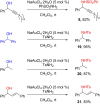Gold-catalyzed propargylic substitutions: Scope and synthetic developments
- PMID: 21804883
- PMCID: PMC3135077
- DOI: 10.3762/bjoc.7.99
Gold-catalyzed propargylic substitutions: Scope and synthetic developments
Abstract
This personal account summarizes our recent developments in gold-catalyzed direct substitutions on propargylic (allylic, benzylic) alcohols, with various nucleophiles (and bi-nucleophiles) based on the σ- and/or π-acidity of gold(III) complexes. Synthetic developments are also briefly described.
Keywords: direct substitutions; gold; isoxazolines; propargylic substitutions.
Figures




















Similar articles
-
Scope and advances in the catalytic propargylic substitution reaction.RSC Adv. 2018 Sep 5;8(54):31129-31193. doi: 10.1039/c8ra04481c. eCollection 2018 Aug 30. RSC Adv. 2018. PMID: 35548716 Free PMC article. Review.
-
A versatile iron-catalyzed protocol for the one-pot synthesis of isoxazoles or isoxazolines from the same propargylic alcohols.Chemistry. 2010 Oct 25;16(40):12207-13. doi: 10.1002/chem.201001461. Chemistry. 2010. PMID: 20842673
-
Facile coupling of propargylic, allylic and benzylic alcohols with allylsilane and alkynylsilane, and their deoxygenation with Et3SiH, catalyzed by Bi(OTf)3 in [BMIM][BF4] ionic liquid (IL), with recycling and reuse of the IL.Org Biomol Chem. 2012 Sep 28;10(36):7347-55. doi: 10.1039/c2ob26046h. Org Biomol Chem. 2012. PMID: 22878594
-
Ruthenium-catalyzed propargylic substitution reactions of propargylic alcohols with oxygen-, nitrogen-, and phosphorus-centered nucleophiles.Chemistry. 2005 Feb 18;11(5):1433-51. doi: 10.1002/chem.200400833. Chemistry. 2005. PMID: 15651018
-
Rhodium-catalyzed acyloxy migration of propargylic esters in cycloadditions, inspiration from the recent "gold rush".Chem Soc Rev. 2012 Dec 7;41(23):7698-711. doi: 10.1039/c2cs35235d. Chem Soc Rev. 2012. PMID: 22895533 Free PMC article. Review.
Cited by
-
Scope and advances in the catalytic propargylic substitution reaction.RSC Adv. 2018 Sep 5;8(54):31129-31193. doi: 10.1039/c8ra04481c. eCollection 2018 Aug 30. RSC Adv. 2018. PMID: 35548716 Free PMC article. Review.
-
An Organometallic Umpolung Approach for Iron-Mediated Propargylic C-H Etherification.Angew Chem Int Ed Engl. 2024 Dec 20;63(52):e202413017. doi: 10.1002/anie.202413017. Epub 2024 Nov 20. Angew Chem Int Ed Engl. 2024. PMID: 39462204 Free PMC article.
-
Tunable Gold-catalyzed Reactions of Propargyl Alcohols and Aryl Nucleophiles.ChemistryOpen. 2022 May;11(5):e202200030. doi: 10.1002/open.202200030. Epub 2022 Mar 10. ChemistryOpen. 2022. PMID: 35274479 Free PMC article.
References
-
- Constable D J C, Dunn P J, Hayler J D, Humphrey G R, Leazer J L, Linderman R J, Lorenz K, Manley J, Pearlman B A, Wells A, et al. Green Chem. 2007;9:411–420. doi: 10.1039/b703488c. - DOI
-
- Emer E, Sinisi R, Capdevila M G, Petruzziello D, De Vincentiis F, Cozzi P G. Eur J Org Chem. 2011:647–666. doi: 10.1002/ejoc.201001474. - DOI
-
- Bisaro F, Prestat G, Vitale M, Poli G. Synlett. 2002:1823–1826. doi: 10.1055/s-2002-34884. - DOI
LinkOut - more resources
Full Text Sources
Research Materials
Miscellaneous
